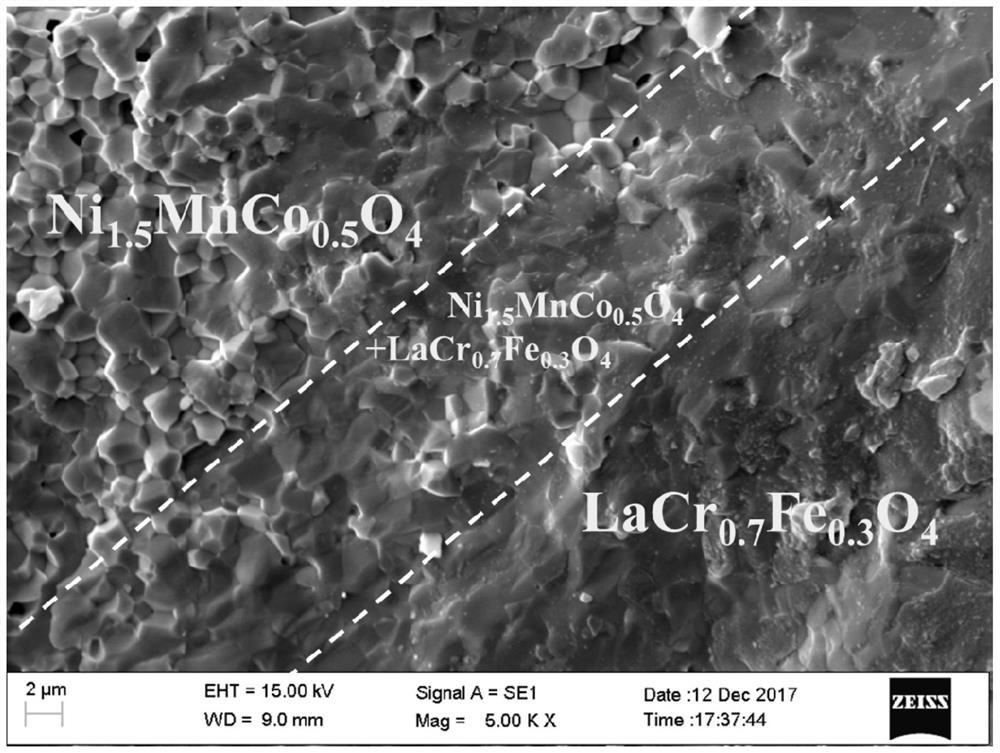An in-situ-generated layered composite negative temperature coefficient thermosensitive ceramic material and its preparation method and application
A negative temperature coefficient, layered composite technology, applied in chemical instruments and methods, ceramic layered products, layered products, etc., can solve the problems of high B value, difficult to obtain, low resistance value, etc., and achieve high B value. , The layer thickness is highly controllable and the effect of reducing the resistance value
- Summary
- Abstract
- Description
- Claims
- Application Information
AI Technical Summary
Problems solved by technology
Method used
Image
Examples
Embodiment 1
[0056] A method for in-situ generation of a layered composite negative temperature coefficient heat-sensitive ceramic material, comprising the steps of:
[0057] (1) Powder preparation:
[0058] Analytical pure La 2 o 3 、Cr 2 o 3 As raw material, according to LaCrO 3 Molar ratio of middle atoms, weighed La 2 o 3 、Cr 2 o 3 , be placed in the agate ball mill jar, take the agate ball as the ball mill medium, deionized water as the dispersion medium, control the mass ratio of each substance in the ball mill jar to be: agate ball: raw material: deionized water=3:1:1, ball mill is smooth Alternate wet milling for 36 hours counterclockwise, with an interval of 1 hour counterclockwise, then dry at 80°C for 24 hours, and grind for 3.5 hours after completion to obtain the first powder for later use;
[0059] To analyze pure MgO, Al 2 o 3 As raw material, according to MgAl 2 o 4 Molar ratio of middle atoms, weigh MgO, Al 2 o 3 , placed in the agate ball mill jar, with the ...
Embodiment 2
[0070] A method for in-situ generation of a layered composite negative temperature coefficient heat-sensitive ceramic material, comprising the steps of:
[0071] (1) Powder preparation:
[0072] Analytical pure La 2 o 3 , MnO 2 , Fe 2 o 3 As raw material, according to LaMn 0.5 Fe 0.5 o 3 Molar ratio of middle atoms, weighed La 2 o 3 , MnO 2 , Fe 2 o 3Place in the agate ball milling jar, take the agate ball as the ball milling medium, and deionized water as the dispersion medium, control the mass ratio of each substance in the ball milling jar to be: agate ball: raw material: deionized water=3:1:1, and the ball milling is forward and reverse Alternate wet milling in the clockwise direction for 24 hours, clockwise and counterclockwise at intervals of 1 hour, then dry at 80°C for 24 hours, and grind for 3.5 hours after completion to obtain the first powder for later use;
[0073] To analyze pure MnO 2 、Ni 2 o 3 , Fe 2 o 3 As raw material, according to NiMn 1.8 ...
Embodiment 3
[0083] A method for in-situ generation of a layered composite negative temperature coefficient heat-sensitive ceramic material, comprising the steps of:
[0084] (1) Powder preparation:
[0085] Analytical pure La 2 o 3 , MnO 2 , CaO as raw material, according to LaMn 0.8 Ca 0.2 o 3 Molar ratio of middle atoms, weighed La 2 o 3 , MnO 2 , placed in the agate ball mill jar, with the agate ball as the ball mill medium, deionized water as the dispersion medium, the mass ratio of each substance in the control ball mill jar is: agate ball: raw material: deionized water=3:1:1, ball mill is smooth Alternate wet grinding for 30 hours counterclockwise, 1 hour interval clockwise, and then dry at 70°C for 24 hours. After completion, grind for 3.5 hours to obtain the first powder and set aside;
[0086] To analyze pure MnO 2 、Ni 2 o 3 As raw material, according to Ni 0.4 mn 2.6 o 4 Molar ratio of middle atoms, weighed MnO 2 、Ni 2 o 3 , placed in the agate ball mill jar, w...
PUM
| Property | Measurement | Unit |
|---|---|---|
| thickness | aaaaa | aaaaa |
| thickness | aaaaa | aaaaa |
| thickness | aaaaa | aaaaa |
Abstract
Description
Claims
Application Information
 Login to View More
Login to View More - R&D
- Intellectual Property
- Life Sciences
- Materials
- Tech Scout
- Unparalleled Data Quality
- Higher Quality Content
- 60% Fewer Hallucinations
Browse by: Latest US Patents, China's latest patents, Technical Efficacy Thesaurus, Application Domain, Technology Topic, Popular Technical Reports.
© 2025 PatSnap. All rights reserved.Legal|Privacy policy|Modern Slavery Act Transparency Statement|Sitemap|About US| Contact US: help@patsnap.com


